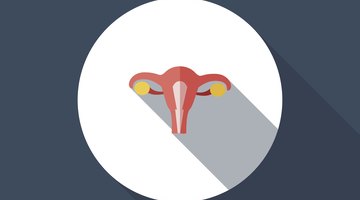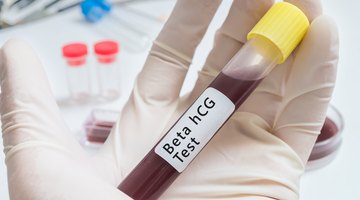Progesterone Levels in the First Trimester of Pregnancy
Progesterone is an important hormone in fertility and pregnancy and is sometimes called the hormone of pregnancy. It plays a vital role in developing and maintaining a healthy placenta and fetus, particularly during the first trimester of pregnancy.
Progesterone levels increase weekly and sometimes daily during the early stages of pregnancy.
If levels are low, your doctor will monitor your pregnancy.
Progesterone is measured in nanograms per milliliter of blood, or ng/ml. Levels vary substantially among women, so average ranges are quite wide.
Gestational Weeks 1 and 2
Gestational age of your baby is clocked from the first day of your last menstrual period.
Although you are not actually pregnant yet, your body is getting ready for the grand event.
Your ovaries are producing small amounts of progesterone, with levels around 0.1 to 1.5 ng/ml, according to an article in the July 2006 issue of "Clinical Chemistry and Laboratory Medicine." Ovulation, or release of an egg for fertilization, will usually occur toward the end of gestational week 2.
Gestational Weeks 3 and 4

Causes of High Hormone Levels During Pregnancy
Learn More
After ovulation, the corpus luteum -- an endocrine body in the ovaries created during ovulation -- begins producing progesterone, and levels start to increase above 2 ng/ml, say the authors of an article in the July 2006 issue of "Clinical Chemistry and Laboratory Medicine."
Progesterone stimulates the uterine lining to thicken, making it ready for implantation of the fertilized egg. Early in gestational week 3, fertilization occurs, and progesterone levels should start to increase by 1 to 3 ng/ml every day or two until a peak of 10 to 29 ng/ml is reached, according to an article in the January 2004 issue of "Gynecological Endocrinology."
Gestational Weeks 5 to 6
By gestational week 6, the average range of progesterone levels is 10 to 29 ng/ml, according to an article in the January 2004 issue of "Gynecological Endocrinology."
Most doctors like to see progesterone levels at least above 6 to 10 ng/ml at this stage, notes a 2012 article in "BMJ."
This level of progesterone stimulates blood vessel growth in the uterus to maintain a healthy, functioning placenta and nourish the embryo. The blood vessel growth occurs all over your body, giving your skin what is often called the pregnancy glow -- or sometimes, rashes and itchiness.
Gestational Weeks 7 to 14

Progesterone and Estrogen Levels in Early Pregnancy
Learn More
Between gestational weeks 7 and 10, the placenta starts to produce progesterone, replacing the corpus luteum as the primary source for the remainder of your pregnancy. Progesterone levels often plateau or sometimes even decrease during this transitional period. After week 10, progesterone levels start to increase again to reach a first-trimester peak of 15 to 60 ng/ml, notes an article in the January 2004 issue of "Gynecological Endocrinology." Levels will continue to increase throughout pregnancy. Expect them to be even higher if you are pregnant with twins or triplets.
These higher levels of progesterone relax smooth muscles in the uterus to help make room for your growing baby and prevent uterine contractions. Unfortunately, the smooth muscle in the digestive tract is also affected, possibly leading to heartburn, indigestion, hemorrhoids and constipation.
Low Levels of Progesterone
Progesterone may be measured during the first trimester to test for an ectopic pregnancy or assess the risk of miscarriage. According to a 2012 article in "BMJ," a progesterone level lower than 6 to 10 ng/ml in gestational week 6 likely indicates that the pregnancy is not viable.
In women who have had 3 or more miscarriages before 20 weeks of gestation, an obstetrician may prescribe progesterone treatment to decrease the risk of spontaneous miscarriage. Studies are underway to better understand the effectiveness of this option. Progesterone supplementation is approved by the Food and Drug Administration to aid in the prevention of premature birth, which is defined as delivery before gestational week 37. If a woman has a history of premature birth and is carrying a single fetus, the American College of Obstetricians and Gynecologists recommends beginning progesterone supplementation between gestational weeks 16 and 20 and continuing through week 36.
Related Articles
- Clinical Chemistry and Laboratory Medicine: Establishment of Detailed Reference Values for Luteinizing Hormone ...
- The Cochrane Library: Progesterone for Preventing Miscarriage
- British Journal of Medicine: Accuracy of Single Progesterone Test to Predict Early Pregnancy Outcome in Women With Pain or Bleeding
- Review of Obstetrics and Gynecology: Progesterone Supplementation and the Prevention of Preterm Birth
- Gynecological Endocrinology: First Trimester Endocrinology: Consequences for Diagnosis and Treatment of Pregnancy Failure
- Nature Clinical Practice Gastroenterology & Hepatology: The Spectrum and Treatment of Gastrointestinal Disorders During Pregnancy
- ACOG Committee Opinion No. 419: Use of Progesterone to Reduce Preterm Birth











